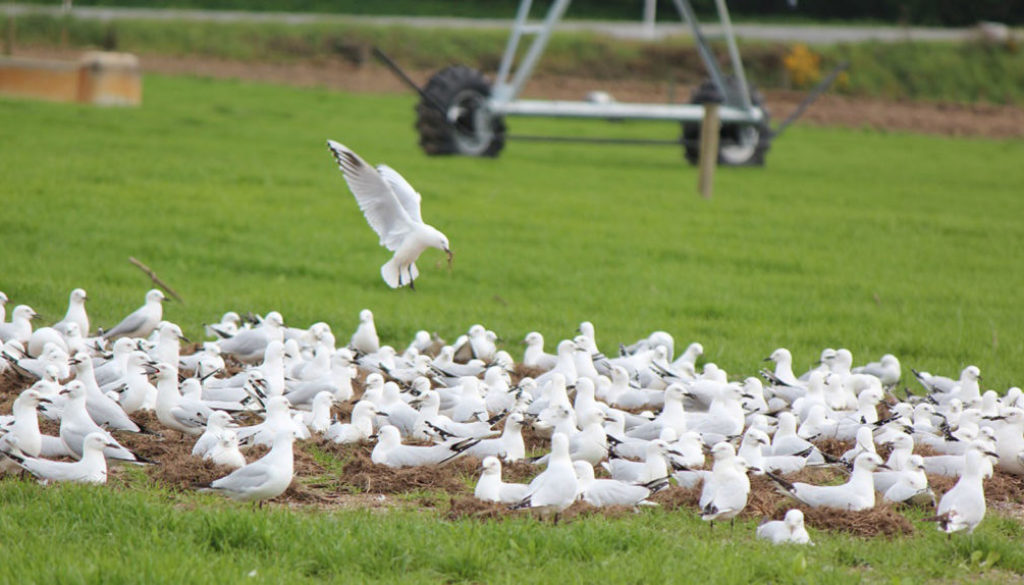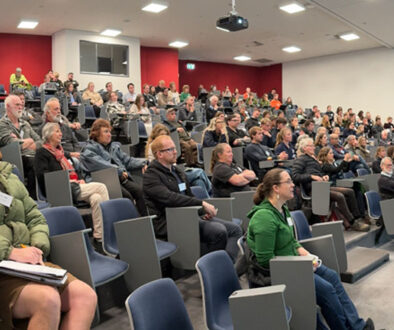Ashley River update
Posted by Nick Legard
Being the wet summer that it has, river flows have been good this season, but it is not the same with bird numbers and breeding success. As stated in the December Update, annual survey numbers were well down on previous years, and breeding success was similar. Our 8 wrybill pairs fledged just 3 chicks – for a productivity of 0.4 (last season they managed 0.7, which was just below the 12-year average of 0.8). There may have been more chicks which fledged, as others were seen at a younger age, but they were not seen flying. The black-fronted terns had an even worse season, probably reflected by the fact that some were still laying eggs in December and January. In my experience, these late breeders very rarely succeed.
The standout success story was the black-billed gulls – not on the river (as none nested there), but down on the dairy farm by SH1. Having a colony of 600-800 birds in the middle of an intensively managed dairy farm was a new experience for all concerned. We wondered how they would handle cows grazing within metres and a centre pivot passing right overhead. I was woken by a phone call at 6.30am to be told that the pivot had just been started for its first run, so gulped down a coffee and raced down to watch. What I did not know was that there was absolutely no need to rush as the pivot moves so slowly that a full 3600 circle takes 2 days! The birds turned out to be not the slightest bit worried by either the pivot or the cows. By early in the New Year, chicks were starting to fly and all have now left the nesting site. Our calculations are that around 300 nests were occupied and that between 300-400 chicks fledged, for a productivity of 1-1.3. We are told by the experts that this is very good. Many thanks to the farm owner and manager, who were keen to assist in any way, and to those who paid regular visits – particularly Grant Davey, who also took some tremendous photos.
Predators
The trapping continues as normal, with 11 members tending around 140 traps. Numbers caught remain low, but are picking up as the autumn approaches. This is normal, due to the breeding season coming to its end, and young ones being pushed out to fend for themselves. The demand for DOC200 traps grows and grows, so Geoff Swailes is constantly ordering components and organising trap making sessions.
These usually last for 4-5 hours and are enjoyable gatherings of like-minded folk – attracted not only by the good cause, but also by the good company and Carol Swailes’ excellent lunches. Extras are welcome, so if you would like to help out, please contact Geoff (3128073).
Weeds
This is now our No 1 concern relative to future bird breeding on the river. Grant Davey has been using aerial photos to determine the extent of invasion over time, and the picture appears to be grim. It may well be the main reason for the decline in bird numbers and breeding this season. As mentioned in the last update, it is not just the obvious lupins, it is also the increase in more permanent gorse and broom (and willow seedlings), plus herbaceous weeds growing in the shallow water feeding sites. We talk about needing a major flood, but ironically, the last one in May 2014, may have been a driver behind our current problem. The size and location of the gorse and broom seedlings indicates that it could have been this flood which introduced seed onto the higher shingle areas – which were relatively weed-free before, and which are the very sites where we most want the birds to breed. The solution will most likely be artificially clearing significant areas by machine. We started this last year (with mixed success), and we will be meeting soon to discuss how we can increase our efforts in the near future.
Public awareness
This continues to be high, with the majority of people sympathetic to our cause and acting accordingly. During the season, we have talked to many schools and groups, manned displays (eg., Ohoka market, outside Warehouse, Tuhaitara Open Day), conducted river visits, and featured in media appearances and articles. Needless to say, as the season closes, these activities slow down.
Ashley-Saltwater creek estuary
This is arguably the foremost estuarine shorebird feeding site on the eastern South Island coast, and is of vital importance to the birds breeding further up the river. Hence it was great to see the Waimakariri District Council adopt the Northern Pegasus Bay Bylaw 2016 in July last year. This plan formally recognises the importance of the estuary and aims to secure its sustainable future. We are very pleased to have been invited to be part of a working party which will oversee its implementation.
BRaid (braided river aid)
BRaid has had its busiest season yet – mostly related to The Flock. This now consists of 100s of birds made by school children, and is still doing the rounds in various Canterbury towns. BRaid has also been involved in promoting local bird monitoring on other rivers, such as the Waiau (large tern colony at the Sharks Tooth), the Harper-Avoca / Wilberforce (working with Trustpower), and the Rakaia river mouth – a major tern and gull breeding site.
Next meeting. This is set down for 6pm on Thursday, February 16 in the DOC offices, River Road. Anyone is welcome to attend.
Nick Ledgard, Chair, Ashley-Rakahuri Rivercare Group Inc




